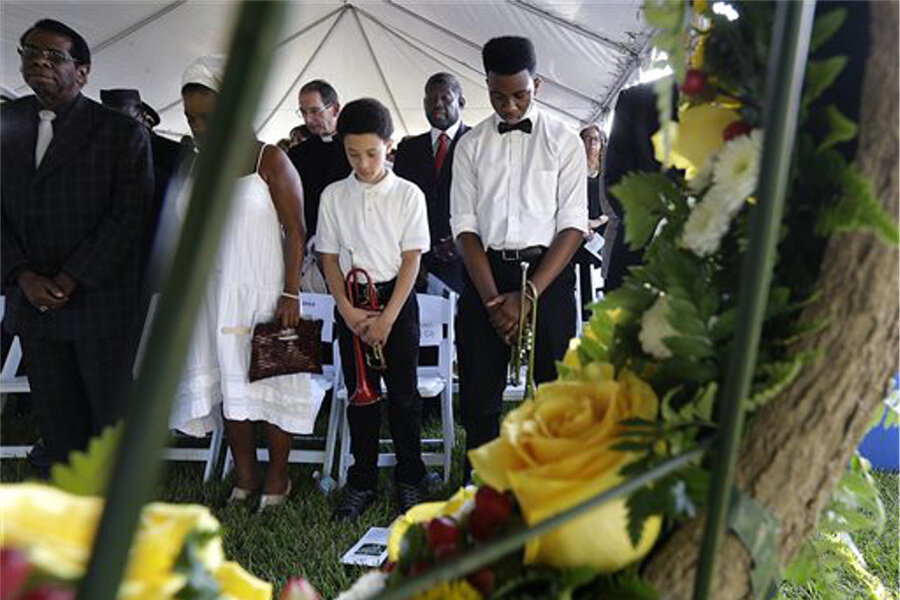From church bells to concerts: How 'unbowed and unbroken' New Orleans memorializes Katrina
Loading...
| NEW ORLEANS
With prayer and the somber ringing of church bells, residents in Mississippi and Louisiana gathered Saturday to mark the 10th anniversary of the day that Hurricane Katrina slammed into their states, causing deadly and costly havoc.
Addressing dignitaries at New Orleans's memorial to the unclaimed and unidentified dead, Mayor Mitch Landrieu spoke of the dark days after the monstrous storm and how the city's residents leaned on each other for support.
"We saved each other," the mayor said. "New Orleans will be unbowed and unbroken."
In Mississippi, meanwhile, churches along coastal Hancock County tolled their bells in unison Saturday morning to mark the 10th anniversary of the day that Katrina made landfall in the state.
Eloise Allen, 80, wept softly into a tissue and leaned against her rusting Oldsmobile as bells chimed at Our Lady of the Sea Catholic Church just across a two-lane street from a sun-drenched beach at Bay St. Louis.
She said her home, farther inland, was damaged but livable. Her daughter lost her home in nearby Waveland. Many of her friends and neighbors suffered similarly.
"I feel guilty," she said. I didn't go through what all the other people did."
In Biloxi, clergy and community leaders were to gather later at MGM Park for a memorial to Katrina's victims and later that evening the park will host a concert celebrating the recovery.
The hurricane's force and flooding ultimately caused more than 1,800 deaths and roughly $151 billion in damage across the region. In New Orleans, wide scale failures of the levee system protecting the city left 80 percent of New Orleans under water.
Katrina's force caused a massive storm surge that scoured the Mississippi coast, pushed boats far inland and wiped houses off the map, leaving only concrete front steps to nowhere.
Glitzy casinos and condominium towers have been rebuilt. But overgrown lots and empty slabs speak to the slow recovery in some communities. As The Christian Science Monitor's Patrik Jonsson wrote:
A confluence of federal dollars, swamp-tested Cajun and Creole resilience, and a “Brooklyn on the Bayou” bohemian aesthetic has brought New Orleans to a place few could have imagined in the dreary aftermath of Aug. 29, 2005. Then, the nation watched transfixed and horrified as 85 percent of a major American city flooded to the eaves, killing hundreds, stranding thousands in attics, and leaving legions of others without homes.
Today, 10 years later, New Orleans is America’s “Lazarus city.” Its main commercial and residential areas are back. It’s hardest-hit neighborhoods are reviving. Since 2007, the city has attracted a higher percentage of college-educated Millennials than any other urban area.
New Orleans is creating start-up businesses at a rate 64 percent higher than the national average, has launched the most ambitious charter school movement in the United States, and is improving its ethics-deficient political and police institutions – all while preserving, for the most part, its bacchanalian identity and gumbo culture.
This is not to say the Crescent City is a complete urban success story. Crime remains virulent, poverty entrenched, and some 100,000 New Orleanians who fled the storm, the vast majority of them poor and black, have never returned. They have been largely replaced by an influx of enterprising young whites, leading some to wonder whether Katrina didn’t unwittingly unleash the nation’s most jarring gentrification movement, forever altering the city’s soul.
On Saturday evening, former President Bill Clinton will headline a free concert-prayer service-celebration at the city's Smoothie King Center. In addition to the former president the event will feature performances by the city's "Rebirth Brass Band," award-winning journalist Soledad O'Brien and Chief Monk Boudreaux and the Wild Magnolias.
The city has framed the 10th anniversary as a showcase designed to demonstrate to the world how far the city has come. In a series of events in the week leading up to the actual anniversary, the city has held lectures, given tours of the levee improvements and released a resiliency plan.
Many parts of this iconic city have rebounded phenomenally while many residents — particularly in the city's black community — still struggle.







